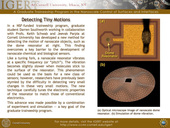Highlight
Detecting Tiny Motions
Achievement/Results
In a NSF-funded traineeship program, graduate student Darren Southworth working in collaboration with Profs. Keith Schwab and Jeevak Parpia at Cornell University has developed a new method for detecting the motion of nanoscale objects, such as the dome resonator at right. This finding overcomes a key barrier to the development of nanoscale chemical and biological sensors.
Like a tuning fork, a nanoscale resonator vibrates at a specific frequency (or “pitch”). The vibration becomes slightly slower when molecules stick to the surface of the resonator. This phenomenon could be used as the basis for a new class of sensors; however, researchers have previously been stymied by the difficulty in detecting very small changes in these very small motions. The new technique carefully tunes the electronic properties of the resonator to match those of conventional electronics.
This advance was made possible by a combination of experiment and simulation — a key goal of the graduate traineeship program.
Address Goals
This activity advances the “Discovery” goal by developing a new technique for the detection of nanoscale motion that is compatible with conventional microelectronics. This technique will be important for the development and implementation of nanomechanical chemical and biological sensors.
This activity advances the “Learning” goal by educating a doctoral student in an area of national need — nanoscale engineering.






